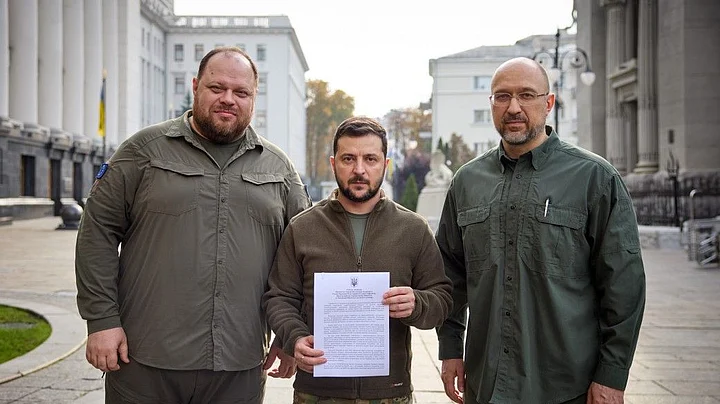Ukrainian President Vlodomyr Zelenskyy on Friday, 30 September, announced that Ukraine was formally applying for a fast-track membership to the North Atlantic Treaty Organisation (NATO).
This came hours after Russian President Vladimir Putin presided over a ceremony at the Kremlin to announce the "referendums" held by pro-Russian authorities in four occupied regions of Ukraine, which recorded huge majorities in favour of joining Russia.
‘Taking Decisive Step’
In a video which is very possibly intended as a rebuttal to the Kremlin and Putin after the latter held a ceremony in Moscow to proclaim four partially occupied Ukrainian territory as annexed Russian land, Zelenskyy "signed" an “accelerated” NATO membership application.
"We are taking our decisive step by signing Ukraine's application for accelerated accession to NATO," Zelenskyy said in a Telegram video.
He was seen announcing the decision and then signing a document with his prime minister and the speaker of parliament alongside him.
“De facto, we have already proven compatibility with alliance standards. They are real for Ukraine – real on the battlefield and in all aspects of our interaction,” Zelenskyy said, according to The Washington Post.
“We trust each other, we help each other, and we protect each other. This is the alliance.”Volodymyr Zelenskyy
Zelenskyy had held an emergency National Security and Defense Council meeting on Friday and denounced the latest Russian strikes.
“The enemy rages and seeks revenge for our steadfastness and his failures,” Zelenskyy posted on his Telegram channel. “You will definitely answer. For every lost Ukrainian life!”
In March this year, Zelenskyy had said that he was no longer interested in making Ukraine a member of NATO, a move which was seen as offering of an olive branch to Putin.
"The alliance is afraid of controversial things, and confrontation with Russia," he had said on joining the US-led transatlantic defence alliance.
Why Now?
Zelenskyy's 30 September announcement came just hours after Putin announced annexation of four occupied regions of Ukraine, days after "referendums" held by pro-Russian authorities.
At a ceremony at the Kremlin to announce the annexation, Putin said, "People living in Luhansk and Donetsk, Kherson, and Zaporizhzhia are becoming our citizens. Forever."
In a ceremony of his own, Zelenskyy "signed" an “accelerated” NATO membership application. He released a video of him putting pen to papers that he said were a formal NATO membership request.
Ukraine's NATO membership application is being widely seen as an immediate response to Putin's annexation announcement.
Ukraine's NATO Membership and the Russian Invasion
Russia had stressed Kyiv interest in joining NATO as one of the key reasons to invade Ukraine in.
Ahead of the February 2022 invasion, Russia had demanded that the issue of Ukraine's relationship with NATO be resolved in its entirety immediately, demanding legally binding guarantees that Ukraine would never be admitted to the alliance.
As NATO was was formed in the wake of World War II to check Russia's influence in Western Europe, Putin has maintained that the organisation's eastward approach is contrary to its promise to Moscow.
At a news conference in December 2021, Putin underscored this point, "You promised us in the 1990s that [NATO] would not move an inch to the East. You cheated us shamelessly."
As early as 14 September this month, the Kremlin said, that Ukraine's ongoing ambitions to join the Western NATO military alliance presented a threat to Russia's security.
How Does a Country Join NATO?
Accession talks with a NATO team
These talks bring together teams of NATO experts and representatives of the individual invitees. In the first session, political and defence or military issues are discussed. The second session includes discussion of resources, security, and legal issues including NATO’s common budget
Invitees send letters of intent to NATO, along with timetables for completion of reforms
The country provides confirmation of its acceptance of the obligations and commitments of membership in the form of a letter of intent. Together with this letter they also formally submit their individual reform timetables.
Accession protocols are signed by NATO countries
NATO then prepares Accession Protocols to the Washington Treaty for each invitee. These protocols are in effect amendments or additions to the Treaty, which once signed and ratified, permit the invited countries to become parties to the Treaty.
Accession protocols are ratified by NATO countries
The governments of NATO member states ratify the protocols, according to their national requirements and procedures.
The Secretary General invites the potential new members to accede to the North Atlantic Treaty
Once all NATO member countries notify the Government of the United States of America, the depository of the Washington Treaty, of their acceptance of the protocols to the North Atlantic Treaty on the accession of the potential new members, the Secretary General invites the new countries to accede to the Treaty.
Country accedes to the North Atlantic Treaty in accordance with their national procedures
Upon depositing their instruments of accession with the US State Department, invitees formally become NATO members
(With inputs from Reuters, The Washington Post.)
